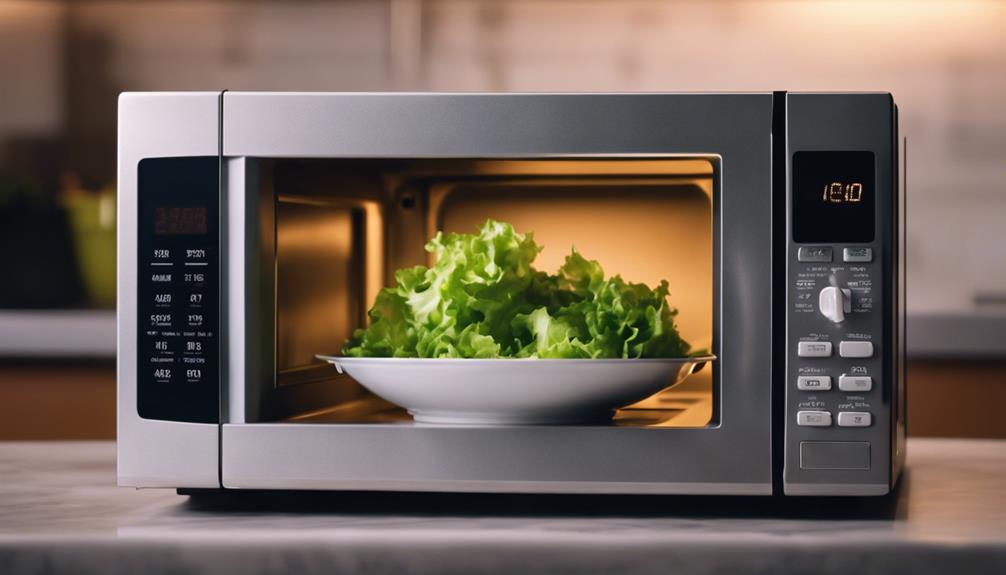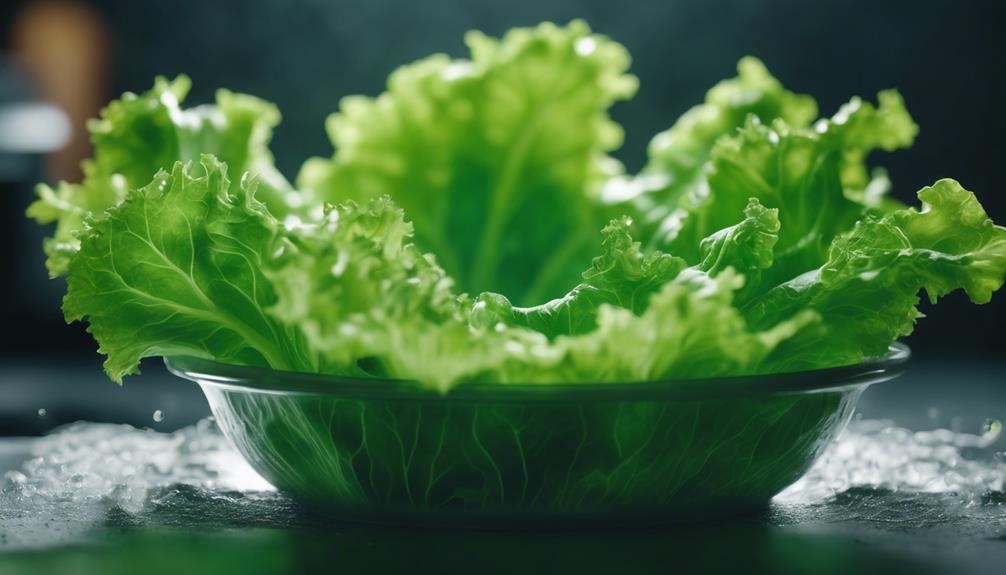No, microwaving lettuce is not recommended. Lettuce is a delicate green that tends to wilt and lose its crispness when exposed to heat, especially in the microwave. This cooking method can result in a mushy and unappetizing texture, significantly diminishing the overall palatability of the lettuce.
Additionally, microwaving lettuce may also lead to a loss of its nutritional value, as the heat can break down important vitamins and minerals. It is best to enjoy lettuce fresh or lightly sautéed for optimal taste and nutritional benefits.
Key Takeaways
- Microwaving lettuce is safe and retains nutrients.
- Microwaving may reduce crispiness but is efficient.
- Follow tips to maintain texture when microwaving.
- Use microwaved lettuce creatively in various dishes.
Safety of Microwaving Lettuce
Microwaving lettuce is commonly regarded as safe and does not present any known health risks, as supported by scientific evidence. There is no research to suggest that microwaving lettuce leads to adverse health effects.
On the contrary, this quick and easy cooking method can help retain vital nutrients in the vegetable. Additionally, claims linking microwaving lettuce to cancer have been debunked.
Using the microwave to cook lettuce is a convenient and efficient way to prepare this vegetable without compromising its nutritional value. When done correctly, microwaving lettuce can be a safe and practical cooking technique that offers a fast solution for incorporating this leafy green into various dishes.
Effect on Taste and Texture
While the safety of microwaving lettuce has been established, it is important to consider the effect this cooking method has on the taste and texture of the vegetable. When lettuce is microwaved, it can lose its crispiness and become wilted and soggy, altering its original texture. The heat exposure during microwaving can also impact the taste of the lettuce. To maintain some crispness and minimize wilting, it is recommended to wash and pat dry the lettuce before microwaving and use paper towels underneath to absorb excess moisture. Exploring alternative cooking methods like steaming or sautéing can help retain a crispy texture for cooked lettuce.
- Wilted and Soggy Texture: Microwaving can lead to a loss of crispiness in lettuce.
- Altered Taste: The heat exposure from microwaving may change the taste of the lettuce.
- Maintaining Crispness: Tips like washing, patting dry, and using paper towels can help preserve some crispness in microwaved lettuce.
Microwave Lettuce for Meal Prep

For efficient meal preparation, utilizing a microwave to cook lettuce can be a convenient and time-saving method. To prevent excessive wilting and maintain texture, start by washing the lettuce thoroughly and patting it dry. Place the lettuce on a microwavable plate lined with paper towels.
Microwave the lettuce in short 30-second intervals on medium heat to avoid overcooking. It is crucial to monitor the lettuce closely during microwaving to achieve the desired warmth without turning it mushy.
For a different approach, consider experimenting with alternative cooking methods such as steaming or sautéing to retain a crispy texture when incorporating lettuce into your meal prep routine.
Reheating Lettuce in the Microwave
Reheating lettuce in the microwave can be a convenient way to warm up your greens quickly, but it requires careful attention to prevent wilting and maintain optimal texture. When reheating lettuce in the microwave, consider the following tips:
- Prep: Wash the lettuce thoroughly, pat it dry to remove excess moisture, and place it on a microwavable plate lined with paper towels.
- Technique: Microwave the lettuce in short intervals of around 30 seconds on medium heat to prevent overcooking and monitor its progress.
- Moisture: Adding a small amount of water to the dish or covering it loosely can create steam, helping the lettuce retain its freshness and crispness.
Alternative Ways to Use Microwaved Lettuce

When looking for innovative ways to incorporate lettuce into your meals, consider trying out a delicious lettuce wraps recipe for a low-carb meal option.
Additionally, mixing lettuce into salads can add a fresh and nutritious boost to your greens.
For a quick and healthy green smoothie, adding lettuce can provide an extra dose of vitamins and minerals to your drink.
Lettuce Wraps Recipe
Leveraging the versatility and nutritional benefits of lettuce, crafting lettuce wraps presents a wholesome and creative alternative to traditional bread-based sandwiches. Lettuce wraps are a versatile and healthy option for a low-carb or weight loss diet.
Here is a simple lettuce wraps recipe to try:
- Choose large, crisp lettuce leaves like iceberg or romaine.
- Fill the leaves with a protein such as grilled chicken, tofu, or shrimp.
- Add veggies like shredded carrots, bell peppers, and cucumber.
- Drizzle with your favorite sauce or dressing, such as soy sauce, peanut sauce, or a vinaigrette.
These lettuce wraps are easy to customize, light on calories, and bursting with flavor, making them a perfect choice for a quick and satisfying meal or snack.
Salad Mix-Ins Ideas
Utilizing lettuce as a mix-in for salads offers a fresh and crunchy texture to elevate your culinary creations. Raw lettuce adds a crisp and light element to salads, enhancing their overall taste and nutritional value.
Consider combining raw lettuce with other vegetables like tomatoes, cucumbers, and bell peppers for a colorful and nutrient-rich salad mix. Additionally, incorporating raw lettuce into salads provides a low-calorie option packed with vitamins and minerals.
Experiment with different types of lettuce such as romaine, iceberg, or leaf lettuce to vary the flavors and textures in your salads. The versatility of raw lettuce as a mix-in allows for endless possibilities to create delicious and wholesome salads.
Smoothie Green Boost
Incorporating microwaved lettuce into smoothies offers a convenient and nutritious way to boost your daily intake of essential vitamins and minerals. By adding this versatile ingredient to your smoothie recipes, you can enjoy a variety of benefits such as enhanced nutrient content and a smoother texture. Here are some key points to consider when using microwaved lettuce for a smoothie green boost:
- Adding microwaved lettuce to smoothies can provide a boost of nutrients like vitamin K, folate, and fiber.
- Microwaved lettuce blends well in smoothies, contributing a mild flavor and smooth texture.
- Using microwaved lettuce in smoothies is a creative way to incorporate leafy greens into your diet.
- Microwaving lettuce for smoothies can help soften the leaves for a smoother consistency.
Frequently Asked Questions
Can Microwaving Lettuce Cause It to Lose Its Nutritional Value?
Microwaving lettuce can cause some loss of nutritional value due to heat exposure. Overcooking may reduce vitamins, minerals, and antioxidants. Short cooking times and minimal heat exposure can help preserve nutrients. Despite some loss, a varied vegetable intake remains beneficial for health.
Will Microwaving Lettuce Make It Wilt Faster Compared to Other Heating Methods?
Microwaving lettuce can accelerate wilting due to quick, intense heat. This method may lead to sogginess compared to steaming or sautéing. To preserve crispness, consider using alternative cooking techniques or microwaving in short bursts with added moisture.
Is It Safe to Microwave Lettuce if It Has Already Been Dressed in a Salad?
Microwaving dressed lettuce may alter its texture and flavor due to the heat exposure. While safe if the salad has been stored properly, it’s best to enjoy lettuce salads fresh to preserve their crispiness and taste.
Can Microwaving Lettuce Release Any Harmful Toxins or Chemicals?
Microwaving lettuce does not release harmful toxins or chemicals. Scientifically, microwaving lettuce is safe and efficient, retaining nutrients. There is no evidence to suggest microwaving lettuce poses health risks. It is a quick and convenient way to cook vegetables.
Does Microwaving Lettuce Affect Its Ability to Be Used in a Cold Salad or Dish Afterwards?
Microwaving lettuce can impact its texture, taste, and visual appeal, making it less suitable for cold salads. Opting for fresh, raw lettuce ensures a crisp and refreshing eating experience. Microwaved lettuce can compromise the overall quality of a cold dish.
Can Microwaving Lettuce Change Its Texture or Make It Wilted?
Microwaving lettuce can indeed change its texture, often resulting in a wilted and soggy outcome. To explore the impact on texture, conduct an experiment comparing microwaved lettuce to fresh lettuce, noting any differences in crispness and appearance.
What Are Some Creative Ways to Incorporate Microwaved Lettuce Into Dishes?
Incorporate microwaved lettuce creatively by making lettuce chips for a crunchy and healthy snack. Season with herbs and spices or use as a base for dips. Enhance salads, wraps, or even sandwiches with this versatile ingredient.
Are There Any Specific Types of Lettuce That Should Not Be Microwaved?
When considering lettuce experiment, it is important to note that delicate lettuces like Bibb or Boston lettuce should be avoided when microwaving. Sturdier varieties such as romaine, kale, and spinach are better suited for this purpose.
Conclusion
In conclusion, microwaving lettuce is a safe cooking method that can be convenient for meal prep or reheating purposes. While microwaving may lead to wilted and soggy leaves, taking precautions such as patting the lettuce dry and using short bursts of heating can help maintain its texture.
Exploring alternative cooking methods like steaming or sautéing may also result in a crispier texture. Overall, microwaving lettuce is a practical option with no known health risks.


